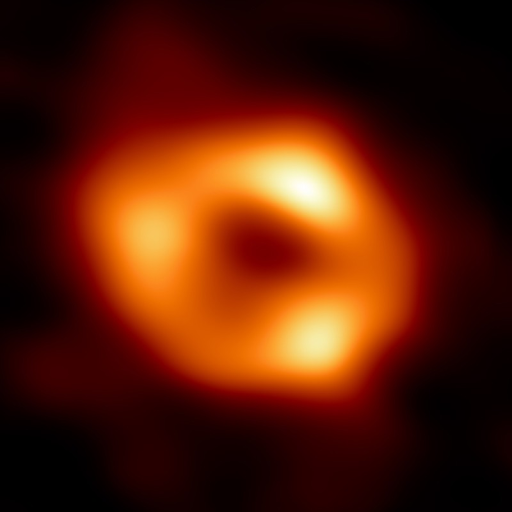The Massive Black Hole at the Center of our Universe

Image via Nature
A blackhole was photographed for the second time in history by the Event Horizon Telescope (EHT) team on May 12th, 2022. These are the same radio physics that created the first photo of blackhole just three years earlier. The newest image released is proof that there is a massive blackhole at the center of the Milky Way galaxy.
Blackholes are formed when a dying star collapses in on itself, creating a singularity with a massive gravitational pull. A black hole’s gravity is so powerful it creates a hole in spacetime, the fabric of the universe as stated in Albert Einstein’s Theory of Relativity. Black holes were first predicted by indirect observations and calculations, but couldn’t be proven for decades because their gravity is so powerful, not even light can escape its event horizon, the “point of no return.” Capturing a photo of something that is invisible was once thought impossible, but the EHT team proved it could be done. “It’s a fulfillment of a dream,” said Heino Falcke, cofounder of the EHT collaboration and an astrophysicist at Radboud University in Nijmegen, the Netherlands. “They’re no longer a fantasy.”
“I think it’s really cool and amazing that we can even see a black hole,” said Dr Ziri Younsi, an astrophysicist and professor in London during an interview with BBC. “It’s extremely far away, and it’s dark. You’re not meant to see a black hole. It traps light, and yet here we are capturing something that’s meant to be invisible. Seeing at the literal edge of space and time, I think that’s truly remarkable.”
This blackhole, Sagittarius A*, gets its name from being located in the Sagittarius constellation that can be seen from earth. Its existence was hypothesized in the 1970s when radio astronomers found a radio source emitting from the center of the Milky Way. The source was too dim and far too large, massing at around 4 million times more massive than our sun.
The previous black hole documented, M87*, was in the M87 galaxy which is about 53 million lightyears away. When the project began, scientists determined that in order to capture an image of the black hole’s event horizon, they would have to essentially use a telescope the size of earth. To even capture an image, they needed resolution 1,000 times sharper than the Hubble Space Telescope’s capabilities. In order to compensate for the sheer quantity of data they would have to use, they took images from eight conservatories around the world as far apart as Spain, Hawaii, Chile, and even the South Pole. The telescopes in all collected 4000 terabytes, so much it couldn’t be transferred over the Internet. The radio physicists took the imaging and strung together to create the image presented.
The second project was a much larger undertaking. M87* was about 1600 times larger and 2000 times farther away, making it and Sagittarius A* about the same size in the sky. The red and orange seen in the picture are of the matter swirling around the black hole (the darker circle in the center). For M87*, the matter was spread across a much larger distance and was more settled, making it easier to gather data over long periods of time. Sagittarius A* wasn’t so easy.
“In M87*, we saw very little variation within a week,” said Helino Falcke. “Sagittarius A* varies on times scales of five to fifteen minutes.”
The culmination of thousands of images were merged together to create the one published. The averages emphasized the most common characteristics of Sagittarius A*, said José Gómez, an EHT member at the Institute of Astrophysics of Andalusia in Granada, Spain.
With their second photograph in the bag, the EHT team is already starting their new project: to capture a movie of a black hole. Being able to observe the black hole’s movements will tell scientists about their physical properties, said Feryal Özel.
“[Black holes] are very violent, powerful objects in terms of their environment,” said Dr Ziri Younsi, “but they’re also responsible for, in many ways, being anchors of galaxies and in a sense for hosting life like ourselves in our own [galaxy].” He said that this is the beginning of a new era in our understanding of black holes. “Objects which were purely theoretical entities are now physical things that we can observe. We’re seeing so close now to the edge of the universe.”

Veronika Owen is the Co-Editor in Chief for the South Lakes Sentinel. She has had a passion for writing ever since third grade. When she’s not...














